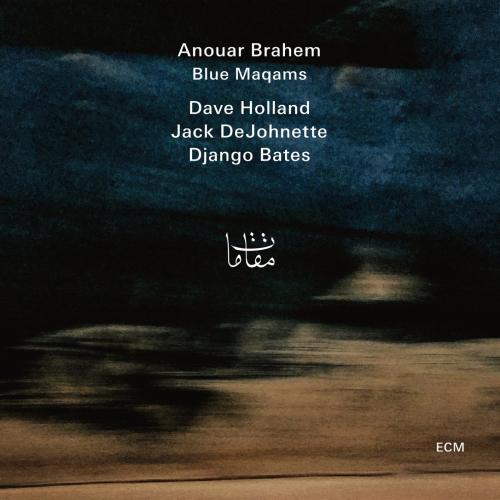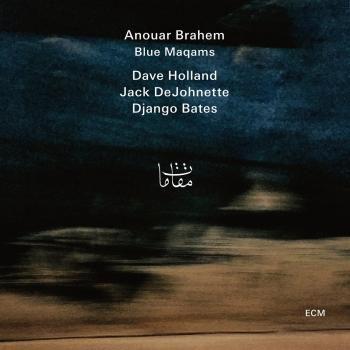
Blue Maqams Anouar Brahem
Album info
Album-Release:
2017
HRA-Release:
13.10.2017
Album including Album cover Booklet (PDF)
I`m sorry!
Dear HIGHRESAUDIO Visitor,
due to territorial constraints and also different releases dates in each country you currently can`t purchase this album. We are updating our release dates twice a week. So, please feel free to check from time-to-time, if the album is available for your country.
We suggest, that you bookmark the album and use our Short List function.
Thank you for your understanding and patience.
Yours sincerely, HIGHRESAUDIO
- 1 Opening Day 07:01
- 2 La nuit 10:29
- 3 Blue Maqams 08:42
- 4 Bahia 08:46
- 5 La passante 04:06
- 6 Bom Dia Rio 09:24
- 7 Persepolis's Mirage 08:07
- 8 The Recovered Road To Al-Sham 09:27
- 9 Unexpected Outcome 10:59
Info for Blue Maqams
Three brilliant improvisers join Tunisian oud master Anouar Brahem in this album, recorded in New York in May 2017. For Brahem and Dave Holland the album marks a reunion: they first collaborated 20 years ago on the very widely-acclaimed Thimar album, a trio recording with John Surman. Brahem meets Jack DeJohnette for the first time here, but Holland and DeJohnette have, of course, been frequent musical partners over the last half-century, beginning with ground-breaking work with Miles Davis: their collaborations are legendary. British pianist Django Bates also rises superbly to the challenge of Brahem’s compositions. And Anouar in turn is inspired to some of his most outgoing playing.
For Anouar Brahem, it’s the work itself that sets a direction. He addresses the question of context and setting only as his music “emerges”: “I simply began in my usual way”, he writes in his liner note for Blue Maqams. “Letting the ideas come in of their own accord, with no tendency one way or another in terms of style, form or instrumentation.” He worked on several sketches in parallel, “and what emerged first and then really began to take shape was my desire to blend the sounds of the oud and the piano once again, soon followed by my wish to associate this delicate instrumental combination with a real jazz rhythm section.”
Although he has never harboured ambitions to be a jazz player, Anouar has long felt a sense of solidarity with the music’s practitioners: “I first started listening to jazz when I was a teenager living in Tunis in the 70s. At the time, I was passionately devoted to the traditional Arab music I’d had the good fortune to study under the great master Ali Sriti. Paradoxically, I was [also] full of curiosity about other forms of musical expression. The aesthetics of jazz were very different to those of Arab music, but I was attracted by this music that took me into a completely different world, one I felt close to as well. Undoubtedly there is a kind of spontaneity in Arab music, a way of playing that allows musicians to go deep into their own feelings and take some liberties with the original score through improvisation; and perhaps this somehow echoes what happens in jazz.”
Brahem began to play with jazz improvisers in the 1980s, with recorded collaborations beginning the following decade. The album Madar (1992) brought Anouar together with saxophonist Jan Garbarek and tabla player Shaukat Hussain, while Khomsa (1994) found him reworking compositions written for film and theatre with improvisers including François Couturier, Palle Danielsson and Jon Christensen. Thimar (1997), with Dave Holland and John Surman, marked a major breakthrough in the space between the traditions, with the participants finding a shared musical language. Blue Maqams takes this notion further. The “maqams” of the title refers to the sophisticated modal system of Arab music, perhaps rendered kind of blue by the participating improvisers.
Dave Holland and Jack DeJohnette have played together on a number of ECM recordings including four albums with John Abercrombie in the Gateway trio, Kenny Wheeler’s Gnu High and Deer Wan, and George Adams’s Sound Suggestions. Brahem first encountered this mighty bass and drums team live in Zurich in the early 1990s, when they were performing with Betty Carter and Geri Allen. “This charismatic rhythm section left a very powerful impression.” Playing live with Dave Holland, on tours with the Thimar trio, was an experience Brahem cherished. “I often told Dave that his playing gave me wings as a soloist. And we spoke, too, about doing more recording. It was a matter, though, of waiting for the right material. But once I’d thought about Dave for this new album, it was very natural to think about Jack, too. It’s an immense privilege to have their participation.” Bringing the jazz drum kit and the soft-singing oud together presents specific dynamic challenges: “I was aware, when I saw that the music would need drums, that this would indeed be challenging, but I also felt that if anybody could address this creatively, it would be Jack DeJohnette, who is one of the most sensitive and subtle drummers. He can move as delicately as a cat, with such a graceful and flowing rhythm.“
Finding the right pianist for the project took longer. “For several months, I listened to a considerable number of players and had many long discussions with Manfred about the style I thought this record needed. Finally, he asked me one day to listen to a recording he’d just made with Django Bates...” [This was The Study of Touch, with Bates’s Belovèd trio with Petter Eldh and Peter Bruun, scheduled for release in November.] “I was highly impressed by Django’s mixture of virtuosic musicianship and lyricism. In the recording studio, I discovered several qualities in Django, not only his dazzling piano technique, but also his creative and inventive powers and his outstandingly strong proposals. He does some absolutely magnificent things on this recording that always bring something new and unusual to the score.”
Balancing freedom and faithfulness to the score is crucial for Anouar Brahem: “I like each piece to keep its own identity in and through written music. The musician’s role is to fit into this universe and express himself inside the framework of this identity.... It’s important for me to keep the true universe of each piece. An important part of our group work has been about this aspect – working together to find the right balance between composed and improvised music. For even in composed pieces or passages where I leave no room for personal interpretation, I like the music to sound as though it surges forth in an inspired, improvised flow.”
The music for Blue Maqams was written between 2011 and 2017, with the exception of two pieces, “Bom Dia Rio” and “Bahia”, both of which were composed in 1990, and revived for this project. Long-term Brahem listeners will be familiar with “Bahia”, a version of which can be heard on Madar.
Blue Maqams was recorded at New York’s Avatar Studios and produced by Manfred Eicher.
Anouar Brahem, oud
Django Bates, piano
Dave Holland, double bass
Jack DeJohnette, drums
Anouar Brahem
was born in 20 th October 1957 in Halfaouine in the Medina of Tunis. Encouraged by his father, an engraver and printer, but also a music lover, Brahem began his studies of the oud, the lute of Arab world, at the age of 10 at the Tunis National Conservatory of Music, where his principal teacher was the oud master Ali Sriti. An exeptional student, by the age of 15 Brahem was playing regularly with local orchestras. At 18 he decided to devote himself entirely to music. For four consecutive years Ali Sriti received him at home every day and continued to transmit to him the modes, subtleties and secrets of Arab classical music through the traditional master / disciple relationship.
Little by little Brahem began to broaden his field of listening to include other musical expressions, from around the Mediterranean and from Iran and India... then jazz began to command his attention. 'I enjoyed the change of environment,' he says' and discovered the close links that exist between all these musics'.
Brahem increasingly distanced himself from an environment largely dominated by entertainment music. He wanted more than to perform at weddings or to join one of the many existing ensembles which he considered anachronistic and where the oud was usually no more than an accompanying instrument for singers. A deepfelt conviction led him to give first place to this preferred instrument of Arab music and to offer the Tunisian public instrumental and oud solo concerts. He began writing his own compositions and gave a series of solo concerts in various cultural venues. He also issued a self-produced cassette, on which he was accompanied by percussionist Lassaad Hosni.
A loyal public of connoisseurs gradually rallied around him and the Tunisian press gave enthusiastic support. Reviewing one of Brahem's first performances, critic Hatem Touil wrote: 'this talented young player has succeed not only in overwhelming the audience but also in giving non -vocal music in Tunisia its claim to nobolity while at the same time restoring the fortunes of the lute. Indeed, has a lutist produced such pure sounds or concretised with such power and conviction, the universality of musical experience'
In 1981, the urge to seek new experiences became ever stronger and his departure for Paris, that most cosmopolitan of cities, enabled him to meet musicians from very different genres. He remained for four years, composing extensively, notably for Tunisian cinema and theatre. He collaborated with Maurice Béjart for his ballet 'Thalassa Mare Nostrum' and with Gabriel Yared as lutist for Costa Gavras’ film 'Hanna K.'.
In 1985 he returned to Tunis and an invitation to perform at the Carthage festival provided him with the opportunity of bringing together, for 'Liqua 85' , outstanding figures of Tunisian and Turkish music and French jazz. These included Abdelwaheb Berbech, the Erköse brothers, François Jeanneau, Jean-Paul Celea, François Couturier and others. The success of the project earned Brahem Tunisia's Grand National Prize for Music.
In 1987, he was appointed director of the Musical Ensemble of the City of Tunis (EMVT). Instead of keeping the large existing orchestra, he broke it up into formations of a variable size, giving it new orientations: one year in the direction of new creations and the next more towards traditional music. The main productions were 'Leïlatou Tayer' (1988) and 'El Hizam El Dhahbi' (1989) in line with his early instrumental works and following the main axis of his research. In these compositions, he remained essentially within the traditional modal space, although he transformed its references and upset its heirarchy. Following a natural disposition towards osmosis, which has absorbed the Mediterranean, African and Far-Eastern heritages, he also touched from time to time upon other musical expressions: European music, jazz and other forms.
With 'Rabeb' (1989) and 'Andalousiat' (1990), Anouar Brahem returned to classical Arab music. Despite the rich heritage transmitted by Ali Sriti and the fact that this music constitued the core of his training, he had in fact, never performed it in public. With this 'return' he wished to contribute to the urgent rehabilitation of this music. He put together a small ensemble, a 'takht', the original form of the traditional orchestra, where each instrumentalist plays as both a soloist and as an improviser. Brahem believes this is the only means of restoring the spirit, the subtlety of the variations and the intimacy of this chamber music. He called upon the best Tunisian musicians, such as Béchir Selmi and Taoufik Zghonda, and undertook thorough research work on ancient manuiscripts with strict care paid to transparency, nuances and details. For more information visit: http://www.anouarbrahem.com
Booklet for Blue Maqams














